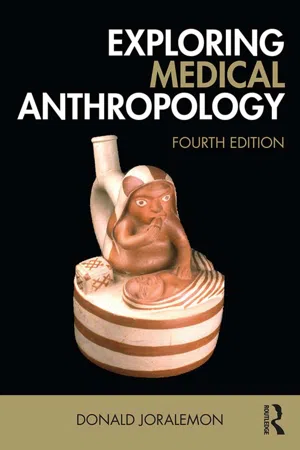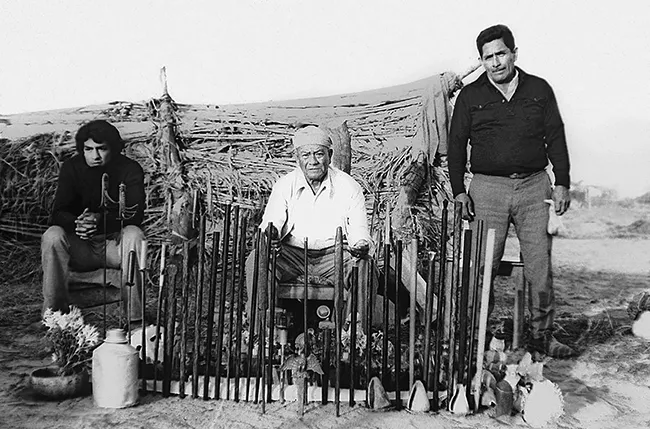Peter Sedgwick, a political scientist from the University of Leeds, challenges the assumption that there is a culture-free way of thinking about disease: “Outside the significance that man voluntarily attaches to certain conditions, there are no illnesses or diseases in nature” (Sedgwick 1981:120–121). Anticipating our response, he continues:
What, are there no diseases in nature? Are there no infectious and contagious bacilli? Are there not definite and objective lesions in the cellular structures of the human body? Are there not fractures of bones, the fatal ruptures of tissues, the malignant multiplications of tumorous growths? Are not these, surely, events of nature? Yet these, as natural events, do not—prior to the human social meanings we attach to them—constitute illnesses, sicknesses, or diseases. The fracture of a septuagenarian’s femur has, within the world of nature, no more significance than the snapping of an autumn leaf from its twig: and the invasion of a human organism by cholera-germs has no more the stamp of “illness” than does the souring of milk by other forms of bacteria (p. 121).
Disease in Other Cultures and Times
Sedgwick’s view of disease, that it is an imposition of human meanings on naturally occurring processes, is somehow less controversial when we study other societies’ beliefs about illness. It seems obvious that the Peruvian shaman’s idea of daño is a culturally laden concept. We can even feel at ease with Sedgwick’s position when examples are drawn from closer to home, provided they are historically remote from our contemporary medical practices. A case in point is the eighteenth-century European and American discussion of “onanism,” a disease that was considered responsible for epilepsy, blindness, vertigo, loss of hearing, headache, impotency, memory loss, rickets, and irregular action of the heart (Engelhardt 1981). We know this dread disease by its modern name, masturbation. The influence of sociocultural values on this disease concept is irrefutable; the fact that the example is two hundred years old makes it easy for us to deny any implications for current biomedicine.
A century closer to the present, it is still possible to point with confidence to the cultural content of American medicine. Publishing in the prestigious New Orleans Medical and Surgical Journal (May 1851), the eminent Dr. Samuel A. Cartwright coined the term “drapetomania” to describe the disease of the mind that “induces the negro to run away from service.” The physician reassured his readers that “with the advantage of proper medical advice, strictly followed, this troublesome practice that many negroes have of running away, can be almost entirely prevented, [even if] the slaves be located on the borders of a free State, within a stone’s throw of the abolitionists” (Cartwright 1981:319).1 No objective science here, but, we reassure ourselves, this is still prior to the real development of scientific medicine.
Feminist scholars contribute additional historical illustrations of the link between medicine and culture in the United States. Barbara Ehrenreich and Deirdre English, in their book For Her Own Good: 150 Years of the Experts’ Advice to Women (1978), describe the nineteenth-century medical view that a woman’s personality and physiology are completely controlled by her ovaries. They cite one authority, Dr. W. W. Bliss, who, in 1870, referred to the:
gigantic power and influence of the ovaries over the whole animal economy of woman—that they are the most powerful agents in all the commotions of her system; that on them rest her intellectual standing in society, her physical perfection, and all that lends beauty to those fine and delicate contours which are constant objects of admiration, all that is great, noble and beautiful, all that is voluptuous, tender, and endearing. … (in Ehrenreich and English 1978:120–121).
The logic of this view led to the diagnosis of an ovarian basis for a wide variety of “diseases,” from tuberculosis and consumption to “simple cussedness” and erotic tendencies. The cure? Ovariotomy, the surgical removal of the ovaries. This operation, by one estimate, had been performed on 150,000 American women by 1906 (Ehrenreich and English 1981:290). It is hard to deny the link between this medical practice and the sociocultural assumptions about gender that helped to define social relations at the turn of the century.
Drs. Cartwright and Bliss were, no doubt, certain that their work rested on firm scientific foundations; they would likely have denied the links that appear so obvious from an early twenty-first-century vantage point between their medical speculations and culturally rationalized forms of social inequality. Could the same be said of physician/researcher and drug promoter Robert Wilson, author of the 1966 best-selling Feminine Forever? Convinced of the value of “estrogen replacement therapy” (ERT) for the treatment of menopausal symptoms, Wilson warned that without ERT “no woman can be sure of escaping the horror of this living decay” (p. 43). His psychiatric colleague David Reuben agreed that menopause was a terrible threat to women. In Everything You Always Wanted to Know About Sex (1966), Reuben wrote that when menstruation ends, “a woman becomes not really a man but no longer a functional woman; these individuals live in the world of inter-sex” (p. 365; see also, MacPherson 1981).
Wilson and Reuben, like their nineteenth-century medical predecessors, seem to have allowed some culturally derived prejudices into their science. They transform a normal process of aging into a disease and link a woman’s social worth and identity to the functioning of her reproductive organs. Whatever may prove to be the advantages and disadvantages of hormonal replacement therapies,2 the significance that Wilson and Reuben attach to menopause is just as value-laden as the examples of ovariotomies, onanism, and drapetomania (see Martin 1987, Lock 1993). A parallel development for male aging is presented in Box 1.1.
But wait: These examples do not come from some historically distant period; they are just decades old. What happened to our scientific, culture-free medicine that seemed so clearly to contrast with the Peruvian shaman’s practice?
The Impact of Culture on Contemporary Biomedicine
The fact is that these are just a few illustrations from a growing body of social science and historical research supporting Sedgwick’s view of the social and cultural embeddedness of all notions of disease and the medical practices they inspire. And it is not just the observations of individual practitioners that have been the focus of this work; medical knowledge, both past and present, has also been analyzed for its sociocultural logic. For example, why do we find North American biomedical texts and popular media of all varieties drawing so heavily on mechanical and combat metaphors to describe organic parts and processes? Why do we speak of the heart as a pump and viruses as invading forces attacking the body’s defense system? Psychologist Samuel Osherson and anthropologist Lorna AmaraSingham (1981) trace the rise of a mechanical metaphor for the functioning of the human anatomy, the body-as-machine, to the shift from a rural, farm economy to an industrial economic base (p. 229). They argue that thinking about the body in mechanical terms has contributed to a dehumanization of clinical practice. They cite the medical management of childbirth: The machine metaphor contributes to the transformation of delivery rooms into factories where “birth [is] the processing of a machine by machines [under the control of] skilled technicians” (Wertz and Wertz, in Osherson and AmaraSingham 1981:236).
BOX 1.1
From ERT to TRT
Do a Goggle™ search for “male menopause”—also called “andropause,” “androgen deficiency in aging males” (ADAM), “partial androgen deficiency in aging males” (PADAM), “viropause,” and “male climacteric”—and you may find the site for reNEWMAN (http://renewman.com), an organization dedicated to “combating the aging process in men.” You will learn that when men reach their mid-forties “hormone levels have dropped to the extent that the erection which once greeted them in the morning ceases, while their muscle definition fades and they notice they are getting a bit flabby around the middle.” But there is an anti-aging cure: testosterone replacement therapy or TRT. Energy returns, depression lifts, sexual interest is recharged, muscles regain definition, and thinking sharpens. At least that’s the promise.
The Food and Drug Administration has approved testosterone treatment for men—irrespective of age—who suffer from medical conditions (e.g., cancer or injury) that trigger testicular or hypothalamic–pituitary dysfunctions that result in low concentrations of testosterone. The accompanying symptoms are bone loss, muscle weakness, lack of energy, diminished sex drive, impaired cognition, and depressed mood. Approval for this limited use does not stop physicians from prescribing TRT more widely.
Entrepreneurial pharmaceutical companies and some physicians argue that the benefits of replacing lost testosterone ought to apply as well to aging men, who experience a reduction in the quantity of this important hormone at a rate of about 1 percent per year after age forty. This promotion of the drug comes despite a shortage of studies evaluating the safety of TRT, especially over the long term, and in the face of concern that artificially elevating levels of testosterone in older men could contribute to prostate cancer, breast cancer, liver disease, and blockages of blood vessels resulting in heart attacks. Prescriptions for TRT in the United States—available as an injection, in tablets, and as skin patches and gel—increased from 648,000 in 1999 to nearly two million in 2002 (Brody 2004).
At a 1995 gathering of the American Academy of Anti-Aging Medicine (A4M) in Las Vegas, Nevada, Dr. Julian Whitaker of the Whitaker Wellness Institute asked, “Are we going to give hormones only to women, while men are supposed to just wither away? Rather than making jokes about grumpy old men, we should keep searching for ways to restore optimal neurochemistry for both sexes” (quoted in Life Extension Magazine, August 2002; http://www.lef.org). For testosterone, “optimal” is defined as the levels of the hormone found in healthy twenty-year-old men (Gould and Petty 2000; Matsumoto 2003); any level below the range in young men is defined as “testosterone deficiency.”
TRT has found a niche in the arsenal of potions aimed at an aging baby-boom generation, including the massively promoted remedies for “erectile dysfunction” and antiaging skin creams. The disturbing déjà vu of an inadequately studied hormonal replacement therapy marketed as a “cure” for the normal effects of life’s later stages seems not yet to have overcome the wish for a fountain of youth.
Anthropologist Emily Martin (1990, 1994) finds the metaphor of disease-as-combat to be pervasive in popular journals and in immunology texts. She suggests that this way of thinking about disease resonated well with the priorities and concerns of the American nation-state during the Cold War. A 1986 National Geographic article, titled “Our Immune System: The Wars Within” (Jaret 1986), makes Martin’s point. The entire text is organized around the combat metaphor, with references to “combatants,” “defenders,” and “penetrations of our defenses.” The arch villain, the AIDS virus, is described as a “virulent scourge that relentlessly disarms the immune system.” Not surprisingly, in an accompanying illustration the invading virus is represented as a red star and the immune system’s parts are miniature “biological arms factories.” Former president Ronald Reagan (1980–1988), known for his anticommunist views, could not have put it any better.3
Just as the machine metaphor has implications for the actual practice of medicine in America, so too does this linked metaphor of disease-as-combat. Expensive high-tech approaches to curing disease find the same compelling justifications as Pentagon budgets: When it comes to conquering the enemy, no cost is too high. Surrender is unacceptable, either on the battlefield or in the hospital. Metaphorical frameworks like these may make complex biological processes easier to understand, but they can also influence the organization and allocation of medical care and even limit our ability to conceive of alternative ways of caring for the sick.
These examples and many others like them confirm Sedgwick’s observation that “The medical enterprise is from its inception value-loaded; it is not simply an applied biology, but a biology applied in accordance wi...

